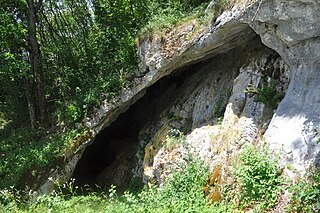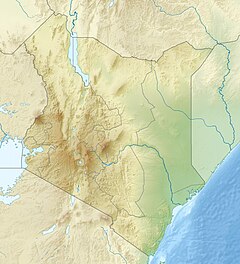
The Omo Kibish Formation or simply Kibish Formation is a geological formation in the Lower Omo Valley of southwestern Ethiopia. It is named after the nearby Omo River and is subdivided into four members known as Members I-IV. The members are numbered in the order in which they were deposited and date between 196 ka ~ 13-4 ka. Omo Kibish and the neighboring formations have produced a rich paleoanthropological record with many hominin and stone tool finds. The Kibish formation, in particular, is most notable for Richard Leakey's work there in 1967 during which he and his team found one of the oldest remains of anatomically modern Homo sapiens. Known as Omo Kibish 1, the fossil was dated to 196 ± 5 ka old and is among two other Omo remains that were found in Member I. The Omo fossils were more recently re-dated to approximately 233 ± 22 ka old. In the early 2000s a research boom enriched the knowledge base about the Kibish Formation. Study of the faunal remains and stone tools provided insight into the archeological associations of Homo sapiens and thereby their behaviors and the complex environmental contexts in which they lived and evolved.

The Later Stone Age (LSA) is a period in African prehistory that follows the Middle Stone Age.
Mumba Cave, located near the highly alkaline Lake Eyasi in Karatu District, Arusha Region, Tanzania. The cave is a rich archaeological site noted for deposits spanning the transition between the Middle Stone Age and Late Stone Age in Eastern Africa. The transitional nature of the site has been attributed to the large presence of its large assemblage of ostrich eggshell beads and more importantly, the abundance of microlith technology. Because these type artifacts were found within the site it has led archaeologists to believe that the site could provide insight into the origins of modern human behavior. The cave was originally tested by Ludwig Kohl-Larsen and his wife Margit in their 1934 to 1936 expedition. They found abundant artifacts, rock art, and burials. However, only brief descriptions of these findings were ever published. That being said, work of the Kohl-Larsens has been seen as very accomplished due to their attention to detail, especially when one considers that neither was versed in proper archaeological techniques at the time of excavation. The site has since been reexamined in an effort to reanalyze and complement the work that has already been done, but the ramifications of improper excavations of the past are still being felt today, specifically in the unreliable collection of C-14 data and confusing stratigraphy.

Cueva Fell or Fell'sCave is a natural cave and archaeological site in southern Patagonia. Cueva Fell is in proximity to the Pali Aike Crater, another significant archaeological site. Cueva Fell combined with the nearby Pali Aike site have been submitted to UNESCO as a possible World Heritage Site.
The Florisbad archaeological and paleontological site is a provincial heritage site in Brandfort in the Free State province of South Africa. The most notable find at this site is the Florisbad Skull, the partial skull of an early human species that was discovered in 1932.

Border Cave is an archaeological site located in the western Lebombo Mountains in Kwazulu-Natal. The rock shelter has one of the longest archaeological records in southern Africa, which spans from the Middle Stone Age to the Iron Age.
The Swan Point Archeological Site is located in eastern central Alaska, in the Tanana River watershed. It is one of a collection of sites in the area that have yielded the oldest evidence of human habitation in the state, in addition to megafauna no longer found in Alaska, such as wapiti (elk), bison, and woolly mammoth. Finds co-located with human artifacts at the site have given radiocarbon dates of 14,000 years, indicating the site was occupied around 12,000 BCE. Swan Point is the oldest archaeological site in the Americas whose age is not disputed.
Elands Bay Cave is located near the mouth of the Verlorenvlei estuary on the Atlantic coast of South Africa's Western Cape Province. The climate has continuously become drier since the habitation of hunter-gatherers in the Later Pleistocene. The archaeological remains recovered from previous excavations at Elands Bay Cave have been studied to help answer questions regarding the relationship of people and their landscape, the role of climate change that could have determined or influenced subsistence changes, and the impact of pastoralism and agriculture on hunter-gatherer communities.
Melkhoutboom Cave is an archaeological site dating to the Later Stone Age, located in the Zuurberg Mountains, Cape Folded Mountain Belt, in the Addo Elephant National Park, Sarah Baartman District Municipality in the Eastern Cape Province of South Africa.

The Eburran industry is the name of an East African tool assemblage that dates from 13,000 BCE and thereafter, found around Lake Nakuru in the Ol Doinyo Eburru volcano complex in the Rift Valley, Kenya.
The Obi-Rakhmat Grotto is a Middle Paleolithic prehistoric site that yielded Neanderthal fossils. It is a shallow karst cave near the junction of the Chatkal and Pskem Rivers at the southwestern end of the Talassky Alatau Range in the Tien Shan Mountains, 100 km (62 mi) northeast of Tashkent, Uzbekistan.

Betal Rock Shelter, a karst cave located on the south-eastern edge of the Lower Pivka river valley on a slope just above the road from Postojna to Bukovje is a site where rich cultural sediment layers with remains of stone tools, artifacts, and numerous fossilized bones of contemporary animals were found. Its entrance was formed by the collapse of the 174 m (571 ft) long cave's ceiling, carved out by the waters of the Pivka River.
Boomplaas Cave is located in the Cango Valley in the foothills of the Swartberg mountain range, north of Oudtshoorn, Eden District Municipality in the Western Cape Province, South Africa. It has a 5 m (16 ft) deep stratified archaeological sequence of human presence, occupation and hunter-gatherer/herder acculturation that might date back as far as 80,000 years. The site's documentation contributed to the reconstruction of palaeo-environments in the context of changes in climate within periods of the Late Pleistocene and the Holocene. The cave has served multiple functions during its occupation, such as a kraal (enclosure) for animals, a place for the storage of oil rich fruits and as a hunting camp. Circular stone hearths and calcified dung remains of domesticated sheep as well as stone adzes and pottery art were excavated indicating that humans lived at the site and kept animals.
Matupi Cave is a cave in the Mount Hoyo massif of the Ituri Rainforest, Democratic Republic of the Congo, where archaeologists have found evidence for Late Stone Age human occupation spanning over 40,000 years. The cave has some of the earliest evidence in the world for microlithic tool technologies.

Kilu Cave is a paleoanthropological site located on Buka Island in the Autonomous Region of Bougainville, Papua New Guinea. Kilu Cave is located at the base of a limestone cliff, 65 m (213 ft) from the modern coastline. With evidence for human occupation dating back to 30,000 years, Kilu Cave is the earliest known site for human occupation in the Solomon Islands archipelago. The site is the oldest proof of paleolithic people navigating the open ocean i.e. navigating without land in sight. To travel from Nissan island to Buka requires crossing of at least 60 kilometers of open sea. The presence of paleolithic people at Buka therefore is at the same time evidence for the oldest and the longest paleolithic sea travel known so far.

Pešturina is a cave in the municipality of Niška Banja in southeast Serbia. It is located southwest of Jelašnica and 20 km (12 mi) southeast of Niš. Artifacts from the Middle and Upper Paleolithic periods were discovered since the archaeological excavations began in 2006. The remains, identified as the Mousterian culture, were dated from 111,000 BP+ 5,000 to 39,000 BP + 3,000, which makes Pešturina one of the latest surviving Neanderthal habitats. The cave has been nicknamed the "Serbian Atapuerca".
Porc-Epic Cave is an archaeological site located in Dire Dawa,Oromia, Ethiopia. Dated back to the Middle Stone Age, the site contains extensive evidence of microlithic tools, bone, and faunal remains. The lithic assemblage reveals that inhabitants at the time were well-organized with their environment. There is also rock art and strong evidence for ochre processing. The site was first discovered in 1920 by H. De Monfreid and P. Teilhard De Chardin. H. Breuil and P. Wernert performed the first excavation in 1933, followed from 1974 to 1976 by J. Desmond Clark and K.D. Williamson. Succeeding this was an excavation in 1998. Porc-Epic Cave provides insight into the behavior and technical capability of modern humans in eastern Africa during the Middle Stone Age.

Panga ya Saidi is an archaeological cave site located in Kilifi County, southeastern Kenya, about 15 km from the Indian Ocean in the Dzitsoni limestone hills. The cave site has rich archaeological deposits dating to the Middle Stone Age, Later Stone Age, and Iron Age. Excavated deposits preserve an unusually long record of human activities, from around 78,000 years ago until around 400 years ago, a chronology supported by radiocarbon dating and optically stimulated luminescence dating. This sequence puts Panga ya Saidi alongside other key sites such as Enkapune ya Muto, Mumba Rockshelter, and Nasera Rockshelter that are important for understanding the Late Pleistocene and the Middle to Later Stone Age transition in eastern Africa.

The Mlambalasi Rock Shelter is a historic site located in Iringa District of Iringa Region in southern Tanzania, 50 km away from Iringa City. Excavations in 2006 and 2010 by the Iringa Region Archaeological Project uncovered artifactual deposits from the Later Stone Age (LSA), the Iron Age, and the historic periods, as well as external artifacts from the Middle Stone Age (MSA). Direct dating on Achatina shell and ostrich eggshell beads indicates that the oldest human burials at Mlambalasi are from the terminal Pleistocene. Mlambalasi is characterized by interment in the LSA and Iron Age periods, as well as by cycles of use and abandonment.

Öküzini Cave, also known as "oxen cave," is located in southwestern Turkey around 32 km northwest of modern Antalya. Situated at the base of the Katran Mountains, the cave overlooks a floodplain stretching towards Antalya and is 900 meters northeast of Karain, a nearby complex of caves. The mouth of the Öküzini Cave is nearly sealed off by large stone blocks, but inside, it has a main chamber reaching 20 meters deep into limestone clefts that further branch into narrow passages. The cave's geological surroundings are marked by the presence of Karst springs in its vicinity, some of which supply drinking water to nearby villages.












